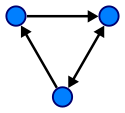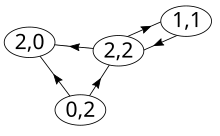Directed graph

A directed graph or digraph is a pair (sometimes ) of:[1]
- a set V, whose elements are called vertices or nodes,
- a set A of ordered pairs of vertices, called arcs, directed edges, or arrows (and sometimes simply edges with the corresponding set named E instead of A).
It differs from an ordinary or undirected graph, in that the latter is defined in terms of unordered pairs of vertices, which are usually called edges.
Sometimes a digraph is called a simple digraph to distinguish it from a directed multigraph, in which the arcs constitute a multiset, rather than a set, of ordered pairs of vertices. Also, in a simple digraph loops are disallowed. (A loop is an arc that pairs a vertex to itself.) On the other hand, some texts allow loops, multiple arcs, or both in a digraph.
Basic terminology
An arc is considered to be directed from to ; is called the head and is called the tail of the arc; is said to be a direct successor of , and is said to be a direct predecessor of . If a path made up of one or more successive arcs leads from to , then is said to be a successor of , and is said to be a predecessor of . The arc is called the arc inverted.
A directed graph G is called symmetric if, for every arc that belongs to G, the corresponding inverted arc also belongs to G. A symmetric loopless directed graph is equivalent to an undirected graph with the pairs of inverted arcs replaced with edges; thus the number of edges is equal to the number of arcs halved.
An orientation of a simple undirected graph is obtained by assigning a direction to each edge. Any directed graph constructed this way is called an oriented graph. A distinction between a simple directed graph and an oriented graph is that if and are vertices, a simple directed graph allows both and as edges, while only one is permitted in an oriented graph.[2][3][4]
A weighted digraph is a digraph with weights assigned for its arcs, similarly to the weighted graph. A digraph with weighted edges in the context of graph theory is called a network.
The adjacency matrix of a digraph (with loops and multiple arcs) is the integer-valued matrix with rows and columns corresponding to the digraph nodes, where a nondiagonal entry is the number of arcs from node i to node j, and the diagonal entry is the number of loops at node i. The adjacency matrix for a digraph is unique up to the permutations of rows and columns.
Another matrix representation for a digraph is its incidence matrix.
See Glossary of graph theory#Direction for more definitions.
Indegree and outdegree

For a node, the number of head endpoints adjacent to a node is called the indegree of the node and the number of tail endpoints is its outdegree.
The indegree is denoted and the outdegree as A vertex with is called a source, as it is the origin of each of its incident edges. Similarly, a vertex with is called a sink.
The degree sum formula states that, for a directed graph
If for every node, v ∈ V, , the graph is called a balanced digraph.[5]
Digraph connectivity
A digraph G is called weakly connected (or just connected[6]) if the undirected underlying graph obtained by replacing all directed edges of G with undirected edges is a connected graph. A digraph is strongly connected or strong if it contains a directed path from u to v and a directed path from v to u for every pair of vertices u,v. The strong components are the maximal strongly connected subgraphs.
Classes of digraphs

An acyclic digraph (occasionally called a dag or DAG for "directed acyclic graph", although it is not the same as an orientation of an acyclic graph) is a directed graph with no directed cycles.
A rooted tree naturally defines an acyclic digraph, if all edges of the underlying tree are directed away from the root.

A tournament is an oriented graph obtained by choosing a direction for each edge in an undirected complete graph.
In the theory of Lie groups, a quiver Q is a directed graph serving as the domain of, and thus characterizing the shape of, a representation V defined as a functor, specifically an object of the functor category FinVctKF(Q) where F(Q) is the free category on Q consisting of paths in Q and FinVctK is the category of finite dimensional vector spaces over a field K. Representations of a quiver label its vertices with vector spaces and its edges (and hence paths) compatibly with linear transformations between them, and transform via natural transformations.
See also
Notes
- ^ Bang-Jensen & Gutin (2000). Diestel (2005), Section 1.10. Bondy & Murty (1976), Section 10.
- ^ Diestel (2005), Section 1.10.
- ^ Weisstein, Eric W. "Oriented Graph". MathWorld.
- ^ Weisstein, Eric W. "Graph Orientation". MathWorld.
- ^ Satyanarayana, Bhavanari; Prasad, Kuncham Syam, Discrete Mathematics and Graph Theory, PHI Learning Pvt. Ltd., p. 460, ISBN 9788120338425; Brualdi, Richard A. (2006), Combinatorial matrix classes, Encyclopedia of mathematics and its applications, vol. 108, Cambridge University Press, p. 51, ISBN 9780521865654.
- ^ Bang-Jensen & Gutin (2000) p. 19 in the 2007 edition; p. 20 in the 2nd edition (2009).
References
- Bang-Jensen, Jørgen; Gutin, Gregory (2000), Digraphs: Theory, Algorithms and Applications, Springer, ISBN 1-85233-268-9
(the corrected 1st edition of 2007 is now freely available on the authors' site; the 2nd edition appeared in 2009 ISBN 1848009976). - Bondy, John Adrian; Murty, U. S. R. (1976), Graph Theory with Applications, North-Holland, ISBN 0-444-19451-7.
- Diestel, Reinhard (2005), Graph Theory (3rd ed.), Springer, ISBN 3-540-26182-6 (the electronic 3rd edition is freely available on author's site).
- Harary, Frank; Norman, Robert Z.; Cartwright, Dorwin (1965), Structural Models: An Introduction to the Theory of Directed Graphs, New York: Wiley.
- Number of directed graphs (or digraphs) with n nodes.















